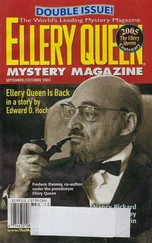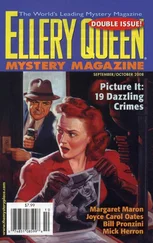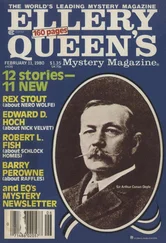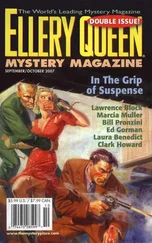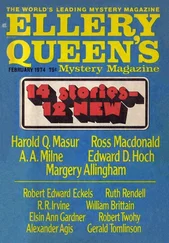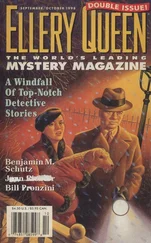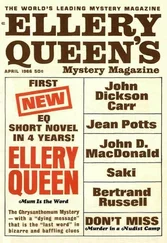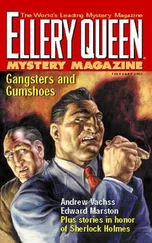Robert Barnard - Ellery Queen’s Mystery Magazine. Vol. 135, No. 2. Whole No. 822, February 2010
Здесь есть возможность читать онлайн «Robert Barnard - Ellery Queen’s Mystery Magazine. Vol. 135, No. 2. Whole No. 822, February 2010» весь текст электронной книги совершенно бесплатно (целиком полную версию без сокращений). В некоторых случаях можно слушать аудио, скачать через торрент в формате fb2 и присутствует краткое содержание. Город: New York, Год выпуска: 2010, Издательство: Dell Magazines, Жанр: Детектив, на английском языке. Описание произведения, (предисловие) а так же отзывы посетителей доступны на портале библиотеки ЛибКат.
- Название:Ellery Queen’s Mystery Magazine. Vol. 135, No. 2. Whole No. 822, February 2010
- Автор:
- Издательство:Dell Magazines
- Жанр:
- Год:2010
- Город:New York
- ISBN:нет данных
- Рейтинг книги:3 / 5. Голосов: 1
-
Избранное:Добавить в избранное
- Отзывы:
-
Ваша оценка:
- 60
- 1
- 2
- 3
- 4
- 5
Ellery Queen’s Mystery Magazine. Vol. 135, No. 2. Whole No. 822, February 2010: краткое содержание, описание и аннотация
Предлагаем к чтению аннотацию, описание, краткое содержание или предисловие (зависит от того, что написал сам автор книги «Ellery Queen’s Mystery Magazine. Vol. 135, No. 2. Whole No. 822, February 2010»). Если вы не нашли необходимую информацию о книге — напишите в комментариях, мы постараемся отыскать её.
Ellery Queen’s Mystery Magazine. Vol. 135, No. 2. Whole No. 822, February 2010 — читать онлайн бесплатно полную книгу (весь текст) целиком
Ниже представлен текст книги, разбитый по страницам. Система сохранения места последней прочитанной страницы, позволяет с удобством читать онлайн бесплатно книгу «Ellery Queen’s Mystery Magazine. Vol. 135, No. 2. Whole No. 822, February 2010», без необходимости каждый раз заново искать на чём Вы остановились. Поставьте закладку, и сможете в любой момент перейти на страницу, на которой закончили чтение.
Интервал:
Закладка:
** Paul D. Gilbert: The Chronicles of Sherlock Holmes, Robert Hale/Trafalgar, $24.95. These seven stories reflect love and respect for the canon in their fresh takes on such untold cases as the vanishing of James Phillimore, the aluminum crutch, the red leech, and the remarkable worm unknown to science. On the downside, narrative and dialogue are appallingly wordy; some anachronisms creep in (most glaringly, “cut to the chase” in the 1890s!); and the lead-off story has the most unconvincing of the many deaths of Moriarty recounted on page or screen.
**** Martin Edwards: Dancing for the Hangman, Five Star, $25.95. In one of the finest fictionalizations of a classic criminal case I’ve ever read, Hawley Harvey Crippen, hanged in 1910 for the murder of his wife Cora (known on the music hall stage as Belle Elmore), tells the story of his life, her death, and his unsuccessful flight from justice with mistress Ethel Le Neve disguised as a boy. An American practitioner of medical quackery living in Britain, he insists he is not a murderer, and that the real murder in the case was never even recognized as such. Edwards, inventing freely without contradicting any of the settled facts of the case, credits his sources in a closing note titled (in homage to John Dickson Carr) “Notes for the Curious.” One example of the excellent and sometimes amusing writing: “To ask a man and a woman to describe a person is akin to commissioning a portrait from painters of different schools.”
*** Colin Harrison: Risk, Picador, $13. Manhattan insurance company lawyer George Young is asked by the elderly and ailing widow of the firm’s founder to find out what her late son was doing the night of his apparently accidental death outside a bar. Though most readers will probably see the main secret coming, this shortish novel (originally a New York Times Magazine serial) offers good writing, an intriguing story, engaging characters, and a vivid rendering of the Manhattan scene.
*** H. R. F. Keating: Inspector Ghote’s First Case, Minotaur, $24.99. The series that began with The Perfect Murder (1964) and seemingly ended with Breaking and Entering (2000) is happily revisited in this prequel. In 1960, newly promoted to full inspector in the Bombay Police Crime Branch, Ghote receives an assignment that will take him away from the city as wife Protima awaits their first child: to find out why the wife of an English friend of the Indian police commissioner killed herself. Character touches, quirky dialect, and Hamlet references support a plot more complex than first appears.
*** Gladys Mitchell: The Longer Bodies, Rue Morgue, $14.95. The first American publication of this 1930 detective novel is remarkably timely, since its plot sounds like a TV reality show: a rich old lady wants to choose the heir to her fortune by having the candidates compete to be the first to represent England in an athletic event (discus, long jump, high jump, pole vault, javelin, shotput). All the Golden Age greats had some humor, but Mitchell was the most determinedly comic, and this elaborate structural edifice could almost be a parody of the classical time-table mystery.
Copyright © 2010 Jon L. Breen
The Camera Never Lies
by John Morgan Wilson
A past Edgar Allan Poe Award winner (for his novel Simple Justice, an entry in a series starring disgraced reporter Benjamin Justice), John Morgan Wilson is continuing to arouse critical enthusiasm for his work. MysteryScene said of his new book, Spider Season: “This exquisite novel is the finest yet in a powerful series.” New readers of the series who want to start at the beginning will be glad to know that Bold Strokes Books has just reissued the first four Benjamin Justice novels.
A Super 8 video camera pans along a sidewalk in a suburban working-class neighborhood. It turns up the front walk of a plain, one-story stucco house. The camera’s weak light points the way through the deepening dusk. The audio records the sound of sneakers softly slapping the pavement.
The footsteps stop as the shooter pauses to focus on an afternoon newspaper lying midway up the walk. He zooms in on the printed date to establish the timeline visually, the way he’s seen it done in the movies. The date is November 3, twenty-two years ago.
The camera rises to slowly pan across the front of the modest house. On either side of the door the windows are dark and the curtains drawn. The camera briefly lingers, as if the shooter is surprised to see them pulled shut so early, or at all.
The camera swings to a Ford pickup parked on a gravel drive. The camera’s POV shifts to the rear of the truck, where it settles for a moment on a green-and-gold decal, shaped like a shield, affixed in a corner of the rear window. Inside the gold border are the words: Los Angeles Sheriff’s Department. Below, a bumper sticker proclaims: My Child Made the Honor Roll at Cesar Chavez Junior High. At the other end, another bumper sticker declares: Guns Don’t Kill. People Do. The shooter fixes purposefully on these details before moving on.
The camera turns up the drive alongside the house. Light glows from a kitchen window that’s set too high for the camera’s eye. A slender hand briefly reaches into frame to push open a gate. The camera enters, pausing to survey a flagstone patio, a small swimming pool, and a towering palm tree at the rear of the yard, rising above several fruit trees.
The camera swings suddenly to the left as a dog bounds across the patio. The dog jumps up, its muzzle going fuzzy as it fills the frame, nose pressed to the lens. A moment later, the dog races back, whimpering and scratching at the back door. A section of white T-shirt comes into frame and wipes the lens clean. The camera’s eye is drawn to the light from a window off the patio. It pushes in to see a man hurry into the kitchen from a hallway — burly, balding, about forty, his mouth grimly set. His brown eyes dart about the room in seeming agitation before he turns abruptly toward the back door. The camera backs quickly away, across the patio and into the shadows of the detached garage. Its light shuts off as the rear porch light comes on. The man opens the door, grabbing the dog before it can get inside. Using a leash, he secures the dog to a post on the patio, ordering the dog to stay in a gruff voice.
The camera follows the man back to the door and into the light from the house. Two or three times, he swings the door on its hinges, studying it intently. He raps his knuckles on the unscreened window in the door’s upper half, as if testing it. Finally, he closes the door from the outside. He grabs a brick from a garden border and smashes the door’s window with a quick, sharp blow. Glass shatters to the floor inside. In the silence that follows, he pricks up his ears and glances furtively about. Satisfied that he’s raised no alarm, he replaces the brick where he found it. He opens the door and steps back into the house.
The camera emerges from the shadows and approaches the kitchen window. It observes the man turn over a chair, knock utensils and a carton of eggs off the counter, and slam his shoulder into the refrigerator with such force that a blender topples, crashing to the floor. He pauses, surveying the mess, then hurries from the kitchen, turning right.
Outside the house, the camera swings urgently in the same direction. On the soundtrack can be heard the whining of the dog, footfalls on the patio, and breathing that grows more rapid.
The camera pulls up at another lighted window and looks into a bedroom. A woman not much younger than the man lies faceup on the disheveled bed, clad in a lacy bra and satiny slip panties of matching pink. Her peroxide blond hair is splayed about her head. An arm is twisted awkwardly beneath her. Smudged red lipstick and an ashen pallor mar her pretty features. Her blue eyes are opened wide, unblinking, and her mouth is agape. The camera loses focus. Its movements become erratic, grabbing images almost at random: Bruising encircling the woman’s throat like a collar. A long, glossy fingernail that looks freshly broken. A striped necktie, lying twisted and crumpled on the pillow beneath her head.
Читать дальшеИнтервал:
Закладка:
Похожие книги на «Ellery Queen’s Mystery Magazine. Vol. 135, No. 2. Whole No. 822, February 2010»
Представляем Вашему вниманию похожие книги на «Ellery Queen’s Mystery Magazine. Vol. 135, No. 2. Whole No. 822, February 2010» списком для выбора. Мы отобрали схожую по названию и смыслу литературу в надежде предоставить читателям больше вариантов отыскать новые, интересные, ещё непрочитанные произведения.
Обсуждение, отзывы о книге «Ellery Queen’s Mystery Magazine. Vol. 135, No. 2. Whole No. 822, February 2010» и просто собственные мнения читателей. Оставьте ваши комментарии, напишите, что Вы думаете о произведении, его смысле или главных героях. Укажите что конкретно понравилось, а что нет, и почему Вы так считаете.

